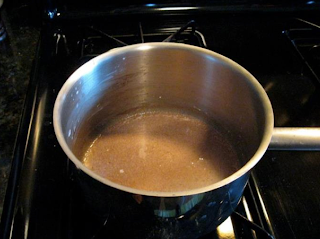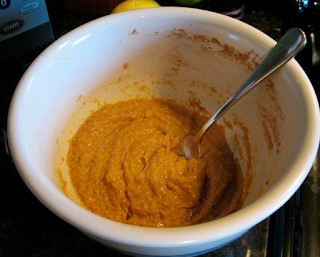Julia Child (a lady who knew what she was talking about) described souffles as a a flavoured base with beaten eggs whites. As the souffle cooks, the air bubbles in the egg whites expand and the souffle rises. That's why souffles collapse as they cool down. As Julia pointed out, souffles basically consist of two ingredients: a base and beaten egg whites. All you need to do is combine them:
"Soufflés are not difficult when you have mastered the beating of egg whites and the folding of them into the soufflé base."Here's a great webpage about souffles with lots of useful tips at the bottom for the first-time souffle maker.
At Halloween last year, Landlord made a cute jack-o-latern. What do you do with all of the leftover pumpkin? I didn't want to make a pumpkin pie because it was close to Thanksgiving and I figured I'd be drowning in pumpkin pies in less than a month. I don't remember why I decided to make a pumpkin souffle. I had never made a souffle before but I figured if it didn't work then I wouldn't have wasted any ingredients. I should mention that at this point I still believed that souffles were impossible to make and I didn't realise that they use so many eggs. I had also heard the urban legend about the Julia Child show where she made a souffle and it collapsed live on television when she pulled it out of the oven. I figured that if Julia Child couldn't get a souffle to work, then it wouldn't be a real failure if my attempt was a disaster.
The pumpkin souffle was amazing, so flavourful and light and the texture was incredible and and and...
I was a souffle convert.
Tips: it's very important to never open the oven door while the souffle is cooking. The heat makes the souffle rise and opening the door lets cool air in. Once a souffle is cooked, you can reinflate it by putting it in the oven at 250 F for 20-ish minutes. But don't open the door while it's cooking for the first time!
Souffles cook more evenly when there's a little bit of water around the base of the ramekin. This keeps the bottom of the ramekin from heating up more than the sides and top. Things can get messy if you're trying to move one big or six to ten little ramekins along with water, so instead you use a cookie sheet. When you're ready to put the souffle in the oven, open the door, pull out the rack, and put a cookie sheet on it. Place the ramekin(s) on the cookie sheet and fill a large cup with water. Pour the water onto the cookie sheet (don't let it splash) until the cookie sheet is about halfway filled up. Then just slide the rack into the oven and close the door. When you're done baking the souffle, take the ramekin out of the oven and leave the cookie sheet and water in the oven to cool down. When you're done eating the souffle, the water will be room temperature and you can dump it out without burning yourself.
For the base, it's important to boil and then simmer. This means that you should see bubbles bursting in the base (boiling) then turn the heat down so that the mixture is still visibly releasing steam but the bubbles are either very small or have gone away entirely.
The base must be cooled down when you add the egg whites or it will cook them before it should.
Egg whites hold "stiff, glossy peaks" when they have been beating with a mixer until they are close to solid. They should have a consistency like whipped cream. Folding the whites means using a spatula or large mixing spoon to very gently mix them into the base. You don't want to deflate the air bubbles in the egg whites or your souffle will never rise.
Pumpkins hold a lot of moisture. Because I was using fresh pumpkin, the souffle took 50 minutes to bake instead of 20 minutes. Although you can't open the oven door, you can take a look through the window to see if the souffle has risen and cooked. A visual inspection should be enough to decide if it's finished or not.
Pumpkin Souffle (don't know where I got this recipe from)
Edit: Found it! This is Gourmet Magazine's Spiced Pumpkin Souffle recipe.
Ingredients
½ cup whole milk
1 tablespoon cornstarch
½ teaspoon ginger
½ teaspoon nutmeg
½ teaspoon and 1 teaspoon cinnamon, divided
½ teaspoon allspice
pinch of cloves
¾ cup and 1 tablespoon sugar, divided
¾ cup pumpkin puree
10 large egg whites
¼ teaspoon salt
Directions
Making the base: whisk together milk, cornstarch, spices, and 1 tablespoon sugar in a small heavy saucepan. Bring to a boil over medium heat, whisking, then simmer while whisking for 2 minutes. Remove from heat and whisk in pumpkin puree. Transfer to a large bowl and cool to room temperature.
Preheat oven to 400 F with rack in the lower third.
Butter ramekin and coat with granulated sugar (knocking out excess). Put ramekin in a large shallow baking pan with 1 ounce of water.
Beat egg whites with salt in another large bowl using an electric mixer until they hold stiff, glossy peaks (1-2 minutes more). Fold ⅓ of whites into cooled pumpkin mixture to lighten, then fold in remaining whites gently but thoroughly. Divide mixture among ramekins or pour into large ramekin. Sprinkle cinnamon and sugar on top to make a cinnamon crust. Bake small souffles for 18-20 minutes or one large souffle for 20-25 minutes (up to 50 minutes if there’s a lot of moisture in pumpkin). Do not open the oven door until finished or the souffle will fall.
Making the base. It looked terrible but tasted great.
What the base looked like after it was cool.
Pumpkin souffle + cream base.
The resulting pumpkin base.
This is what ten egg whites look like.
Folding the egg whites into the base.
The mixture in the prepared large ramekin.
Success! One pumpkin souffle.








No comments:
Post a Comment